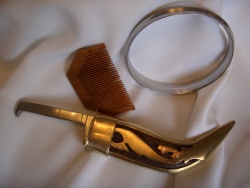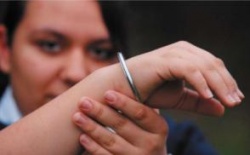School uniform and the 5ks

It is believed that the school uniform plays a valuable role in contributing to the ethos of a school and setting an appropriate tone in the school environment. The uniform is a symbol of a student’s pride in himself/herself and an outward sign of association with a particular school. Many experts in this field encourage schools to have a uniform as it can instil pride; support positive behaviour and discipline; encourage identity with, and support for, school ethos; ensure pupils of all races and backgrounds feel welcome; protect children from social pressures to dress in a particular way; and nurture cohesion and promote good relations between different groups of pupils. Above all, many schools believe that school uniform supports effective teaching and learning
School uniforms are common in primary and secondary schools in many nations. They are the most widely known form of student uniform; other types of which include uniforms worn by students participating in higher vocational training, such as in health occupations.
Traditionally, school uniforms have been subdued and professional. Boys' uniforms often consist of dark trousers and light-colored shirt, tie. Girls' uniforms vary greatly between countries and schooling systems, but typically consist of a dress or a blouse worn either with a skirt, culottes or under a pinafore. Gender-specific uniforms have been a point of contention, with some schools permitting female students to choose either skirts or trousers while still requiring male students to wear trousers. The use of a blazer or suit-like jacket for either gender is also fairly common, especially in cold weather.
In continental Europe, they have not been required in public (state-sponsored) schools. Private schools, though, often have a school uniform or a strict dress code.[citation needed] This is different in the United Kingdom and Ireland, however, where the majority of state secondary schools adopt a uniform for a more formal look.
Details
In most countries, the school's management body decides on the uniform policy or dress code that operates in the school. It is generally the headteacher's responsibility to make sure that students keep to the rules set by the policy. Schools must ensure that its school uniform policy is fair, reasonable and that the uniform chosen is affordable and does not act as a barrier to parents when choosing a school. A school must have regard to its obligations under the Human Rights Acts and anti-discrimination legislation.
The Human Rights Act protects the right of all to "manifest one's religion or beliefs". Various religions and beliefs require their adherents to conform to a particular dress code, or to otherwise outwardly manifest their belief. Some religions require adherents to wear or carry specific religious artefacts, others may hold a belief that they should not cut their hair, and a number of religions require their followers to dress modestly, for example, by wearing loose fitting clothing, or covering their head.
The school uniform policy must conform to the requirements of the Human Rights Act and also ensure that it is non-discriminatory so that pupils of all religions are able to comply with the uniform requirement without sacrificing on the religion ethics. In fulfilling its obligations, a school may have to balance the rights of individual pupils against the best interests of the school community as a whole. However, the School will have to have a very good reason before it can infringe on an individual's human right.
This was confirmed in July 2008 by the recent judgement in the High Court in the UK in the case of Sarika Singh v Aberdare Girls’ School. This case involved a Sikh girl and a steel bangle called a Kara. Sikhs are mandatorily required by their faith to wear the 5ks – five articles of faith. It appears from this judgement and others in respect of other Sikhs and their article of faith that as the requirement to wear the 5ks is compulsory in their faith, the school must do its best to accommodate their requirement as far as possible.
The fact that a pupil may be under a compulsory requirement by his or her religion to wear a certain item of clothing or other apparels has to be accommodated by the school if at all possible. The school has a responsibility to accommodate in their uniform policy all religion requirements unless they can clearly justify otherwise. However, the school must should very good reason for restricting the religious requirements of the individual.
Where a school has good reason for restricting an individual's freedoms, for example, to ensure the effective delivery of teaching and learning, the promotion of cohesion and good order in the school, the prevention of bullying, or genuine health and safety or security considerations, then the restriction of an individual's rights to manifest their religion or belief may be justified.
In the News
Australian school apologises Sep 2, 2008
Australian school apologises for refusing Sikh pupil SYDNEY (AFP)
An exclusive Australian school on Tuesday apologised for refusing to enrol a 12-year-old Sikh boy unless he discarded his turban and cut his hair to conform with the school's uniform regulations.
The apology formed part of a settlement won after the boy's parents complained to Queensland state's Anti-Discrimination Commission after he was turned away from Ormiston College in the eastern city of Brisbane in 2006.
Sikhs were outraged by the school's stance as their religion mandates that the faithful should wear turbans and not cut their hair.
"Ormiston College has apologised for any hurt that may have resulted from the decision, and have undertaken to review their enrolment practices and uniform policy to ensure that it does not act in breach of the Anti-Descrimination Act 1991 (Queensland)," the school said in a statement.
The lawyer for the boy's family, who cannot be identified for legal reasons, said the family was happy with the confidential out-of-court settlement, which included the public apology.
"The main thing they wanted was broader understanding within the community to the importance of being able to choose an education whilst maintaining your religious beliefs and identity," said Scott McDougall.
"We're hopeful that other schools will take note and it won't be repeated upon the Sikh community," he told the Australian Associated Press.
The boy was now attending another private school where he was allowed to wear his turban and was doing well, the lawyer said.
Ormiston College's headmaster, Brett Webster, said it was pleased the case had been resolved.
"What we have done is we've agreed to look at our policies and that's a commitment we will take seriously," he said.
"And if there's a need to modify our enrolment or uniform policies to remain aligned with the Anti-Discrimination Act then we will do so."
UK Judgement 29-July-2008

(photo: www.independent.co.uk)
- Main article: Sarika Singh
Girl wins religious bangle case at 11.00am London time 29 July 2008 - The Press Association
A Sikh teenager excluded from school for breaking a "no jewellery" rule by refusing to remove a wrist bangle which is central to her faith was a victim of unlawful discrimination, a judge ruled.
As a result of the judgment in the High Court, Sarika Watkins-Singh, 14, will be returning to Aberdare Girls' School in South Wales in September - wearing the Kara, a slim steel bracelet.
Her lawyers had told Mr Justice Silber that the Kara was as important to her as it was to England spin bowler Monty Panesar, who has been pictured wearing the bangle.
Sarika, of mixed Welsh and Punjabi origin, of Cwmbach, near Aberdare, was at first taught in isolation and eventually excluded for refusing to take off the bangle in defiance of the school's policy, which prohibits the wearing of any jewellery other than a wrist watch and plain ear studs.
The judge declared that the school was guilty of indirect discrimination under race relations and equality laws.
After the judgment, Sarika's mother, Sinita, 38, said: "We are over the moon. It is just such a relief."
Afterwards, a spokeswoman for the family hailed it as a "common sense" judgment.
Sarika said: "I am overwhelmed by the outcome and it's marvellous to know that the long journey I've been on has finally come to an end. I'm so happy to know that no-one else will go through what me and my family have gone through." She added: "I just want to say that I am a proud Welsh and Punjabi Sikh girl."
See also
- See Wikipedia article on School uniform and the 5ks for more information
- Sarika Singh
- The right to wear the 5Ks
- Mandla v Dowell Lee
- National Protest by UK Sikhs
- Turban, UK Legislation Regarding its use by Sikhs
- Articles of faith
- Turban
- Sample letter regarding 5ks
External links
- cist.org.uk The Five Ks
- bbc.co.uk 'Bangle' pupil is excluded again
- abc.net.au A Brisbane private school has agreed to review its uniform policy after a Sikh family claimed it was discriminatory
- afp.google.com Australian school apologises for refusing Sikh pupil
- direct.gov.uk Uk Government guidelines in school uniform
- teachernet.gov.uk DCSF guidance to schools on school uniform and related policies
- Should school uniforms be mandated in elementary schools?
- Long Beach Unified School District Uniform Initiative: A Prevention-Intervention Strategy for Urban Schools, The
- NAESP : >>Information and Resources: Public School Uniforms
- What's in a school uniform? BBC
| These articles deal with Sikh's Five ks |
|
Kesh (uncut hair) -|- Kara (bangle) -|- Kanga (small comb) -|- Kachera (under garment) -|- Kirpan (sword) |
